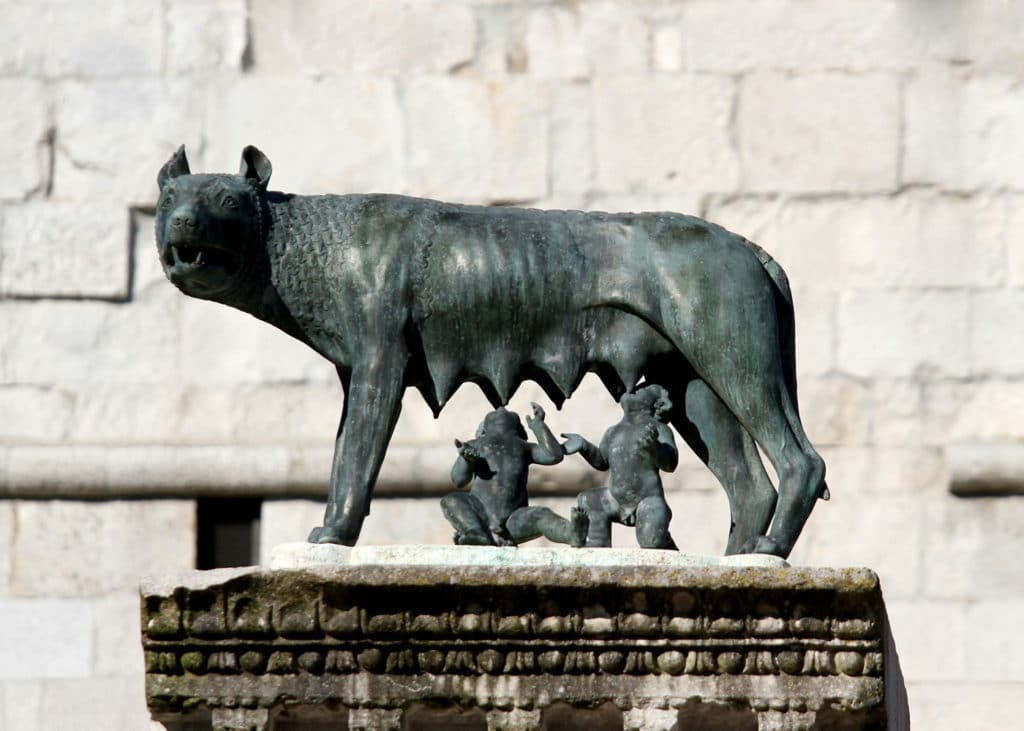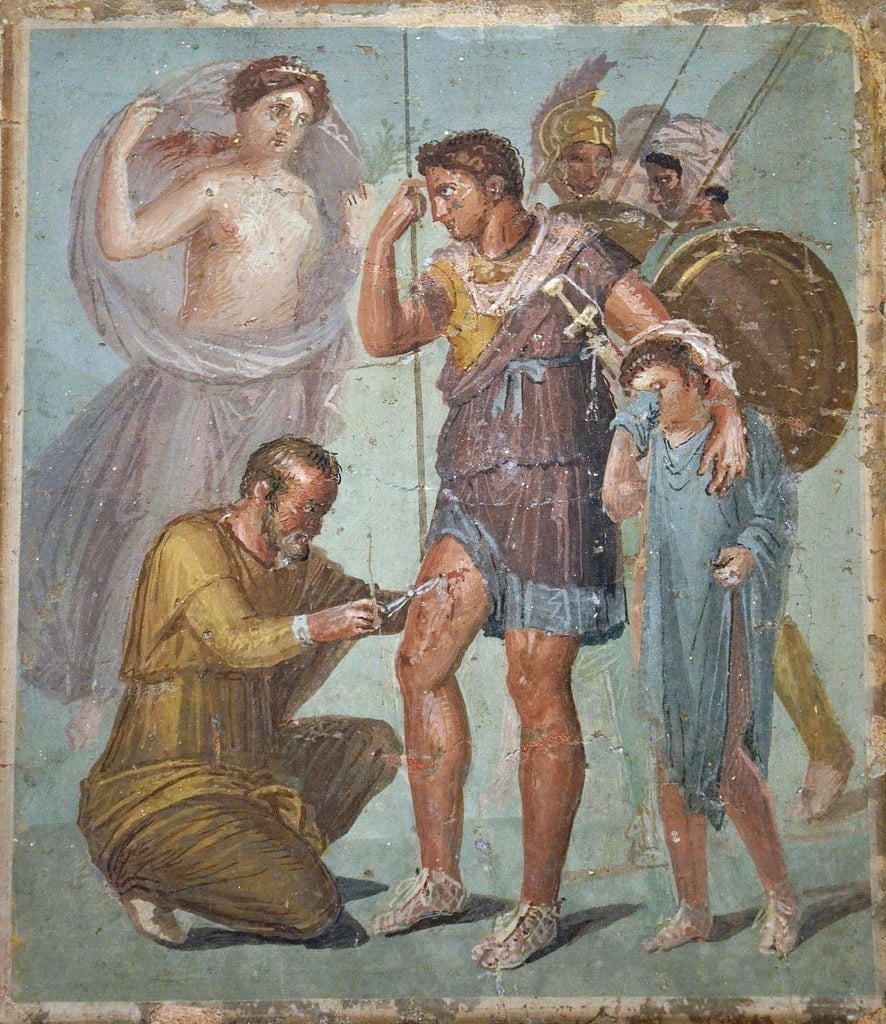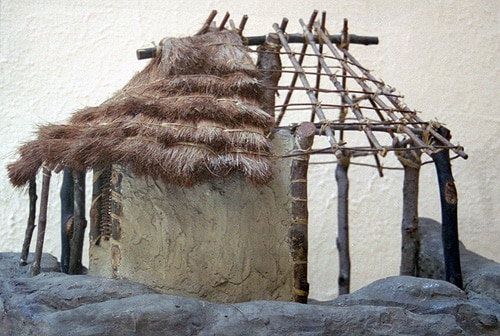Period: 1200 – 625 BC
The Founding of Rome is very much embroiled in myth. Traces found by archaeologists of early settlements of the Palatine Hill date back to ca 750 BC. This ties in very closely with the established legend that Rome was founded on 21 April 753 BC, which was traditionally celebrated in Rome with the festival of Parilia.
Two founding of Rome legends exist – Romulus and Remus, and Aeneas. Rather than contradict each other, the tale of Aeneas adds to that of Romulus and Remus.
The Founding of Rome – Romulus and Remus
King Numitor of Alba Longa was ejected by his younger brother Amulius. To do away with any further possible pretenders to his usurped throne, Amulius murdered Numitor’s sons and forced Numitor’s daughter, Rhea Silvia, to become a vestal virgin. (Vestal virgins were priestesses to the goddess Vesta and were expected to guard their virginity in the goddess’ honor on pain of death.)
However, Mars, the god of war became enchanted by her beauty and had his way with Rhea Silvia while she slept. As a result of this Rhea Silvia bore twins, Romulus and Remus. An enraged Amulius had Rhea Silvia thrown into the river Tiber where she was caught beneath the waves by the river god who married her.
The twins were set adrift on the river in a reed basket. They floated downstream until the basket was caught in the branches of a fig tree. This was where they were found by a she-wolf who suckled them (wolves are sacred to Mars) until a shepherd found them.

Another version of the same story about the founding of Rome, tells of the shepherd finding them and taking them to his wife, who had just lost a stillborn child and who breastfed them. The tale says the shepherd’s wife was a former prostitute. Which one of the two versions is the original is hard to tell. In Latin lupa means both ‘she-wolf’ and ‘prostitute’.
As the two boys had grown into men in the care of the couple, they were told of their true origins. True to their heroic status they raised an armed and marched on Alba Longa. Amulius was slain in battle and Numitor was restored to his throne.
The twins decided to find a new city close to where they had been washed ashore, caught by the fig tree. The twins disputed which hill their city should be built on, Romulus favoring the Palatine, Remus choosing another (possibly the Aventine).
Taking the auspices to read the will of the gods, Remus on his hill saw six birds, and Romulus saw twelve. So it was decided that Romulus’ choice was the right one and he and his followers took to building their city on Palatine Hill.
Romulus took to marking the city’s sacred boundary with a plow drawn by a white bull and a white cow. Remus however leapt over the furrow, either in jest or derision. This was an ill omen suggesting the city’s defenses could easily be overcome. Remus was slain, either by Romulus himself or by one of his chief followers.

The Founding of Rome – Aeneas
If the tale of Romulus and Remus appears as the more popular Roman founding tale today, then the tale of Aeneas, harking back to yet earlier times, was perhaps the more popular in the days of the Roman Empire. In fact, through Virgil, the Aeneid became the national epic of the Roman Empire and the most famous poem of the Roman era.
Aeneas was to have been a hero fighting the Greeks in the Trojan wars. The son of Venus and a mortal father, he escaped as the great city of Troy was sacked. After quite an odyssey he landed in Latium through which the river Tiber flows. Aeneas married the daughter of King Latinus, only to aggrieve King Turnus of Rutuli who himself had his eye on her. As usual in ancient tales, there ensued a war for the princess between Turnus and Aeneas, who was by then supported by King Tarchon of the Etruscans.
Naturally, Aeneas, son of Venus, was triumphant.
The sack of Troy is dated to around 1220 BC. To fill the years from Aeneas to Romulus the Romans therefore were required to produce a string of fictional Kings to make the tale work. This was done across all the generations with some ease from Ascanius, son of Aeneas to Numitor, grandfather of Romulus and Remus.

The Founding of Rome – Historical Background
As such the Latins settled in the wider area of Rome around 1000 BC. However, those early settlements were not to be mistaken for anything like a city. They kept pigs, herded sheep, goats, and cattle, and lived in primitive, round huts.
So how could such archaic beginnings ever lead to a city of power which would rule the world? The rise of Rome was certainly not inevitable, but it had many advantages right from the start. Rome lies only a few miles from the sea with all its possibilities of trade. It lies central to the Italian peninsula, which in turn lies central to the entire Mediterranean Sea. Italy is guarded by the Alps to the North and by the sea all around.
Add to this the influence of the Greeks who were settling in southern Italy, founding cities like Cumea and Tarentum, bringing advanced civilization to the country, and you have a place with lots of potential. From the Greeks, the Romans learned fundamental skills such as reading and writing, even their religion is almost entirely derived from Greek mythology. i.e. for Jupiter write Zeus, Mars is Ares, Venus is Aphrodite, etc…
If the Greeks settled to the south of them, then the Romans had the Etruscans to the north. Etruria was predominantly an urban society, drawing its considerable wealth from seaborne trade. The extravagant Etruscans were generally seen by the more hardy Romans to be decadent and weak.

While being distinctly unique in their own right, the Etruscans too owed much of their culture to the Greeks. At around 650 to 600 BC, the Etruscans crossed the Tiber and occupied Latium. It is through this, so one believes, that the settlement on the Palatine Hill was brought together with the settlements on surrounding hills, either in an attempt to fend off the invaders or, once conquered, by the Etruscan master who sought to rule their kingdom via a structure of city-states. It is at this point that the first known, rather than mythical, kings emerge.
The Founding of Rome Chronology
1200 BC
Beginning of the first Iron Age. The Prisci Latini migrated to Italy from the Danube region.
c. 1000 BC
Latins settle in Latium
Beginning of Etruscan migrations into Italy
10th Century BC
First settlement on the Palatine Hill on the future site of Rome
753 BC
Foundation of the city of Rome (according to Varro)
C. 750 BC
Beginning of Greek colonization in Italy: the foundation of Ischia, Cumae (754), Naxos in Sicily (735), Syracuse (c.734)
c. 700 BC
Etruscan civilization begins to flourish
c. 750-670 BC
Septimonium: the union of settlers of Palatine, Cermalus, Velia, Fagutal, Cuspius, Oppius, and Caelius
c. 650 BC
Etruscan expansion into Campania
c. 625 BC
Historical Founding of Rome
People Also Ask About the Founding of Rome:
How did Rome get founded?
Romulus and Remus fought for leadership. Romulus built a strong wall around Palatine Hill and set up a powerful government, thus establishing the foundations of Ancient Rome on April 21, 753 BCE. Romulus even named the city after himself, as its natural founding father and king. That’s the story about the founding of Rome.
Why is it so difficult to prove how Rome was founded?
The story of the founding of Rome is very complex. Rome was founded at a time before history was routinely written down, and when it was founded, it was just a little collection of people on the banks of the Tiber River. Perhaps if anyone then had an inkling of what glory the city was destined for, they would have paid closer attention and kept better records.

Historian Franco Cavazzi dedicated hundreds of hours of his life to creating this website, roman-empire.net as a trove of educational material on this fascinating period of history. His work has been cited in a number of textbooks on the Roman Empire and mentioned on numerous publications such as the New York Times, PBS, The Guardian, and many more.
